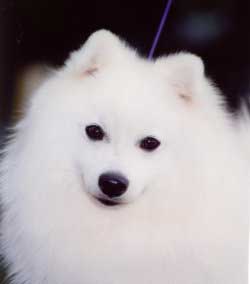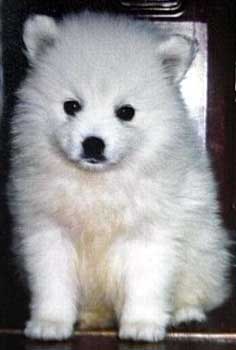Japanese Spitz breed Information
|
One look at that sweet little face nestled in that fluffy pillow of white fur, and your heart will no doubt melt. Though the Japanese Spitz is a relatively new breed (possibly residing in Australia and America for 40 years or so), it has won the hearts of dog lovers everywhere! Thanks to Yvonne Luther's Kennels for the pictures of puppies & adults used on this page, and the additional information provided.
|
|||||
|
Breed information: History – There is some disagreement found in the exact origin of the breed. Some experts maintain that the breed is a larger variety of the Samoyed line, but most believe that the origin can actually be found in the European (German) Spitz-type dogs, dating back as early as 500 A.D. At best, the Japanese Spitz can probably claim to be distant cousins with the Pomeranian, American Eskimo Dog, and the Samoyed, even if based mainly on resemblance alone. However, the first solid history we have on the beginnings of the Japanese Spitz can be found in the early 1900s. In 1920, breeders in Japan brought together several varieties of Spitzes from around the world, starting with the slightly smaller German Spitz, with the intention of creating an even better companion breed. Just after 1945, the final standard for the Japanese Spitz was adopted by the Japanese Kennel Club. After that, the popularity of the breed really took off! It was brought from Japan to Sweden, then England (becoming recognized by the UKC in 1977), Australia, and the United States. While this fluffy, white snowball is recognized by many Kennel Clubs throughout the world, the AKC is not one. Unfortunately, its strong resemblance to the American Eskimo precludes it from consideration (at least at this time). Breed Standards – In terms of breed standards, the average height of males is about 37cm/14.5,” while females are a bit smaller at 30cm/11.5." If intending to show, the key proportion for the dog is 10:11 (ratio of height at withers to length of body). Average weight range is between 5-7kg/11-15.5lbs. Coat color is only white (the German Spitz comes in a variety of colors). Other characteristics of the breed include a wedge-shaped head, a thick under-layer of the longhaired coat (coat is shorter the lower it gets on the dog), a tail covered with long hair (curling over the back), small ears which are pointed upright, and a slightly-tapered muzzle. The large oval eyes are always dark brown or black, almond shaped, and gently slanted. The nose and lips are also always black. For any other specifics, you can also contact your local Japanese Spitz breeder. Energy – While the breed is a very adaptable, intelligent breed, they do not require large amounts of exercise. For that reason, along with their compact size, they make wonderful dogs for almost any environment ranging from small apartments to houses with large, fenced-in yards. They love attention and are extremely playful and happy, but, as with most small dogs (especially the highly intelligent varieties), they can be prone to some mischievous or destructive behavior if left alone for too long without adequate stimulation. This is referred to as “Small Dog Syndrome,” and the best treatment for it is the prevention of it! A good dose of daily walks or play should be sufficient to keep your pup happy and healthy. Because of their small size and easy-going disposition, the Japanese Spitz also travels very easily and enjoyably. Temperament – The breed was developed solely for the purpose of being an ideal companion dog…and it looks like that breeding succeeded! These are very family-centric dogs, and they love to be with their human pack. While they enjoy being with people other than family, it may take a meeting or two for them to not appear “standoffish” or aloof. They warm quickly though! And if you stop to think about it, their way of “observing” a stranger, rather than jumping on them and slathering them with kisses, is a remarkable and desirable trait to most dog owners (who usually have to apologize or restrain their dogs when visitors arrive). On looks alone, your Japanese Spitz will stand out and get lots of attention, so be prepared. Gorgeous, seemingly smiling, and not outwardly aggressive, the breed becomes more and more comfortable with people and pets alike with early and consistent socialization. Unlike most small dogs, the Japanese Spitz does well with children (especially family), and have been known to join in for a good, energetic play session with the kids. Also unlike some other highly-intelligent varieties of dog, the Japanese Spitz is easily trainable, eager to please, and very obedient. Once you establish the rules, be sure to stick to them (don’t let that sweet face weaken your resistance!), though puppies of this breed usually only need to be shown the rules once or twice before they are on the same page with you. Thanks to their keen ears and alert nature, the Japanese Spitz makes an excellent watchdog. And of course, due to their love of family and pack, the Japanese Spitz is also a very protective breed. They have no problem alerting the pack to dangers or unknown people, though their small size might not go very far in terms of actual protection (they very rarely attack or bite in any regard). When you combine all of these endearing traits, it’s understandable why you may be hard pressed to find older abandoned Japanese Spitz dogs in a shelter or rescue. Indeed, the breed is so beloved by owners that once they become first-time Japanese Spitz owners, they become life-long fans! Health – Perhaps due to stringent standards when the breed began in Japan, but the breed is remarkably free from most genetic health issues. For the most part, they live long, happy lives of 10-16 years, which also makes them one of the longest-lived breeds! If they do suffer from health issues, they usually revolve around the dislocation of the kneecap (patellar luxation) and occasional runny eyes (due to allergies or small tear ducts, though this is not considered a genetic condition). Grooming – The long, luxurious coat might suggest one of two things: high-maintenance grooming is required, or the dog will have excellent tolerance to cold temperatures. Oddly, neither is true! While these dogs can tolerate the cold, they would much prefer to be inside, safe and warm with the family. And despite the long, white coat, the Japanese Spitz is actually considered to be a low maintenance breed. The secret lies in the coat’s texture. Dirt and mud tend to simply dry and then fall off (or can be easily brushed out). And even though this dog loves to go out in the yard, roll around, and have fun while getting dirty, the breed is fastidious when it comes to keeping itself clean. Like a cat, the Japanese Spitz will lick itself clean! As far as owner-maintenance goes, thanks to their own cleaning rituals, your pup really only requires a bath two or three times per year! The coats do shed once per year, lasting 7-10 days, but the dead hair can easily be combed out. Your local Japanese Spitz breeder can provide even more guidelines, tips, and tricks in caring for your beloved dog. Negatives – Believe it or not, the cuteness factor of the Japanese Spitz can be considered a negative of the breed…only because it helps them get away with some mischief (especially as puppies)! Another negative might be slight standoffish behavior toward strangers…but in the long run, that is probably a beneficial trait (for both the dog owner and the visitor). Positives – The positives that can be found in the Japanese Spitz are almost endless! You can’t even count their fluffy coat against them, since it requires so little grooming! Happy, intelligent, obedient, easily trained, easy to groom, protective, adaptable to all living spaces, not requiring large amounts of exercise, gorgeous to look at, and a world-class companion… what else could you want in a dog? Is it any wonder why the Japanese Spitz is one of the most-loved, most-recommended breeds in the world? Depending on where you live, you may need to search to find a breeder…but your search would be well-worth the trouble!
|
|||||
Breeders |
|||||
|
|||||








